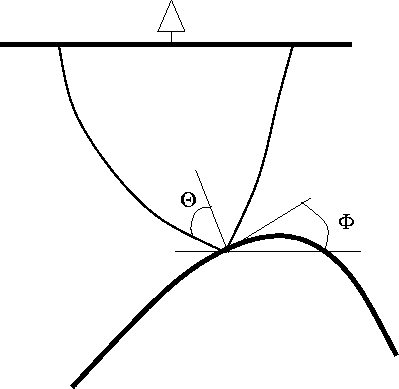Migration in the reflection angle domain is a subsurface-oriented technique.
It is most easily understood as a Kirchhoff method. For each point in
the subsurface (![]() ), a ray couple can be created for a certain
reflection angle (
), a ray couple can be created for a certain
reflection angle (![]() ) and a certain dip angle (
) and a certain dip angle (![]() ) as shown in
Figure 1. To create a CIG, simply sum over all of
the dip angles:
) as shown in
Figure 1. To create a CIG, simply sum over all of
the dip angles:
| (1) |
|
rangle
Figure 1 Geometry of the reflection angle |  |
In this paper, we actually use a wave-equation method to create
the RAD CIG. We begin by using the Double Square Root (DSR) equation
to downward continue the data (represented
as the wavefield recorded at the surface
![]() where
where ![]() indicates
the frequency domain,
indicates
the frequency domain, ![]() is the midpoint location, hx is offset,
and z is depth), then we
slant stack (transforming the data into vertical traveltime space
is the midpoint location, hx is offset,
and z is depth), then we
slant stack (transforming the data into vertical traveltime space ![]() )at each depth level and image at zero time:
)at each depth level and image at zero time:
 |
(2) | |
| (3) | ||
| (4) |
The actual CIG is extracted at a fixed midpoint.
The resulting CIG has an axis that is in offset ray parameter (phx)
rather than reflection angle (![]() ). However, the offset ray
parameter is related to the reflection angle by:
). However, the offset ray
parameter is related to the reflection angle by:
| (5) |
Sava and Fomel (2000) describe an alternative method of obtaining RAD CIGs in the Fourier domain.
The advantages of the RAD in helping to reduce illumination problems are not immediately obvious. Imagine upward continuing a wavefield from a reflector below a complex structure such as a salt dome. As the wavefield passes through the complex structure, the energy gets spread out unevenly over a large distance. In the offset and shot domains, this distribution can lead to the loss of energy that is present but doesn't conform to the regular surface-oriented geometry. The subsurface-oriented reflection angle domain does not have this difficulty. Unfortunately, there is another problem. Our acquisition geometry is always finite, therefore we can never record the entire wavefield at the surface. When we downward continue the finite recorded wavefield, the "missing" data creates a model null space. This null space cannot be filled with migration alone, so we turn to inversion.